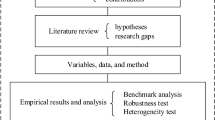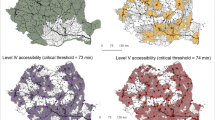Abstract
This study applied a threshold panel data model to test the nonlinear impacts of tourism development and the potential moderating effect of tourism density on urban livability, using observations of 35 large and medium-size cities in China from 2002 to 2016. Findings revealed that the total effect of tourism development on urban livability first increased and then decreased with the growth of tourism density. Thus, tourism development was found to have a critical impact on urban livability, both positively and negatively, with a non-monotonic moderating effect of tourism density. Results lead to practical managerial implications regarding tourism sustainability and urban livability.


Similar content being viewed by others
References
Agarwal S (2005) Global-local interactions in English coastal resorts. Tour Geogr 6(4):351–352
Baidal JAII, Sánchez IR, Rebollo JFV (2013) The evolution of mass tourism destinations: new approaches beyond deterministic models in Benidorm (Spain). Tour Manage 34:184–195
Bimonte S, Punzo LF (2016) Tourist development and host–guest interaction: an economic exchange theory. Ann Tour Res 58:128–139
Bryden J, Faber M (1971) Multiplying the tourist multiplier. Soc Econ Stud 20(1):61–82
Buettner T, Ebertz A (2009) Quality of life in the regions - Results for German counties. Ann Regional Sci 43(1):89–112
Butler RW (1980) The concept of a tourist area cycle of evolution: Implications for management of resources. Can Geogr 24(1):5–12
Chen JS (2001) Assessing and visualizing tourism impacts from urban residents’ perspectives. J Hospital Tourism Res 25(3):235–250
Chyxx (2017) Analysis on the tourism reception, tourism income and foreigner inbound tourists of China in 2016. Retrieved from https://www.chyxx.com/industry/201703/502603.html
Cole S (2012) Synergy and congestion in the tourist destination life cycle. Tour Manage 33(5):1128–1140
Cracolici MF, Nijkamp P (2009) The attractiveness and competitiveness of tourist destinations: a study of southern Italian regions. Tour Manage 30(3):336–344
Dodds R, Joppe M (2003) The application of ecotourism to urban environments. Tourism Int Interdiscip J 51(2):157–164
Geng ST, Xie YJ (2013) Research on coupling relation between tourism economy and ecological environment of China’s sub-provincial cities. Urban Develop Stud 20(1):91–97
Gilbert D, Clark M (1997) An exploratory examination of urban tourism impact, with reference to residents attitudes, in the cities of Canterbury and Guildford. Cities 14(6):343–352
Glaeser E, Kourtit K, Nijkamp P (eds) (2020) Urban empires: Cities as global rulers in the new urban world. Routledge, London
Hanafiah MH, Hemdi MA, Ahmad I (2016) Tourism destination competitiveness. Tour Econ 22(3):629–636
Hansen BE (1999) Threshold effect in non-dynamic panels: estimation, testing and inference. J Econom 93(2):345–368
Higgins-Desbiolles F (2018) Sustainable tourism: sustaining tourism or something more? Tourism Manag Perspect 25:157–160
Høyer KG (2000) Sustainable tourism or sustainable mobility? The Norwegian case. J Sustain Tour 8(2):147–160
Huang XY, Zhen F, Cao XS, Wang L (2015) Concept, elements and framework of livabile transportation based on multi-dimensional objectives. Hum Geogr 30(5):77–83
Hunt C, Stronza A (2014) Stage-based tourism models and resident attitudes towards tourism in an emerging destination in the developing world. J Sustain Tour 22(2):279–298
Kaltenborn BP, Haaland H, Sandell K (2001) The public right of access - some challenges to sustainable tourism development in Scandinavia. J Sustain Tour 9(5):417–433
Kim K, Uysal M, Sirgy MJ (2013) How does tourism in a community impact the quality of life of community residents? Tour Manage 36:527–540
Kourtit K, Nijkamp P, Stough RR (eds.) (2015) The Rise of the City, Edward Elgar, Cheltenham
Kourtit K, Nijkamp P, Wahlström MH (2020) How to make cities the home of people – a ‘soul and body’ analysis of urban attractiveness. Land Use Policy 111:104734
Lee CC, Chang CP (2008) Tourism development and economic growth: a closer look at panels. Tour Manage 29(1):180–192
Levin A, Lin CF, Chu CSJ (2002) Unit root tests in panel data: asymptotic and finite-sample properties. J Econom 108(1):1–24
Li J (2020) Culture and tourism-led peri-urban transformation in China – the case of Shanghai. Cities 99:102628
Liu J, Han BI, Wang M (2020) Using multi-source data to assess livability in Hong Kong at the community-based level: a combined subjective-objective approach. Geograph Sustain 1(4):284–294
Liu J, Nijkamp P, Huang X, Lin D (2017a) Urban livability and tourism development in China: analysis of sustainable development by means of spatial panel data. Habitat Int 68:99–107
Liu J, Nijkamp P, Lin D (2017b) Urban-rural imbalance and tourism-led growth in China. Ann Tour Res 64:24–36
Llop M, Arauzo-Carod JM (2012) Identifying the economic impact behind a cultural asset: an input–output subsystems analysis. Ann Regional Sci 49(3):861–877
Rátz T, Smith M, Michalkó G (2008) New places in old spaces: mapping tourism and regeneration in Budapest. Tour Geogr 10(4):429–451
Roberts B, Stimson RJ (1998) Multi-sectoral qualitative analysis: a tool for assessing the competitiveness of regions and formulating strategies for economic development. Ann Regional Sci 32(4):469–494
Rong XB, Zhen-Hua HU, Xiong X (2016) Regional differences in the coupling relationship between tourism development and ecological civilization construction. Econ Geogr 36(8):189–194
Ruth M, Franklin RS (2014) Livability for all? Conceptual limits and practical implications. Appl Geogr 49:18–23
Seraphin H, Sheeran P, Pilato M (2018) Over-tourism and the fall of Venice as a destination. J Destin Mark Manag 9:374–376
Singh S (2011) The tourism area ‘life cycle’: a clarification. Ann Tour Res 38:1178–1187
The State Council the People’s Republic of China (2013) National plan for sustainable development of resource-based cities (2013–2020). Retrieved on 27 August, 2019, from http://www.gov.cn/zwgk/2013-12/03/content_2540070.htm
Timur S, Getz D (2009) Sustainable tourism development: how do destination stakeholders perceive sustainable urban tourism? Sustain Dev 17(4):220–232
Tsaur SH, Yen CH, Teng HY (2018) Tourist–resident conflict: a scale development and empirical study. J Destin Mark Manag 10:152–163
Uysal M, Sirgy MJ, Woo E, Kim H (2016) Quality of life (QOL) and well-being research in tourism. Tour Manage 53:244–261
Veenhoven R, Ouweneel P (1995) Livability of the welfare-state. Soc Indic Res 36(1):1–48
Woo E, Kim H, Uysal M (2015) Life satisfaction and support for tourism development. Ann Tour Res 50:84–97
Xie PF (2003) The bamboo-beating dance in Hainan, China: Authenticity and commodification. J Sustain Tour 11(1):5–16
Acknowledgements
This work was supported by: National Natural Science Foundation of China (No. 41801138), National Social Science Foundation of China (No. 19BJY202), and Humanities and Social Sciences of Ministry of Education Planning Fund of China (NO. 19YJAZH046). We also acknowledge a grant of the Romanian Ministry of Research and Education, CNCS-UEFISCDI, project nr PN-III-P4-ID-PCCF-2016-0166 within the PNCDI III project ReGrowEU—Advancing Ground-Breaking Research in Regional Growth and Development Theories through a Resilience Approach towards a Convergent, Balanced and Sustainable European Union.
Author information
Authors and Affiliations
Corresponding author
Additional information
Publisher's Note
Springer Nature remains neutral with regard to jurisdictional claims in published maps and institutional affiliations.
Rights and permissions
About this article
Cite this article
Liu, J., Chen, J.M., Nijkamp, P. et al. Threshold effect of tourism density on urban livability: a modeling study on Chinese cities. Ann Reg Sci 70, 315–331 (2023). https://doi.org/10.1007/s00168-022-01118-w
Received:
Accepted:
Published:
Issue Date:
DOI: https://doi.org/10.1007/s00168-022-01118-w




